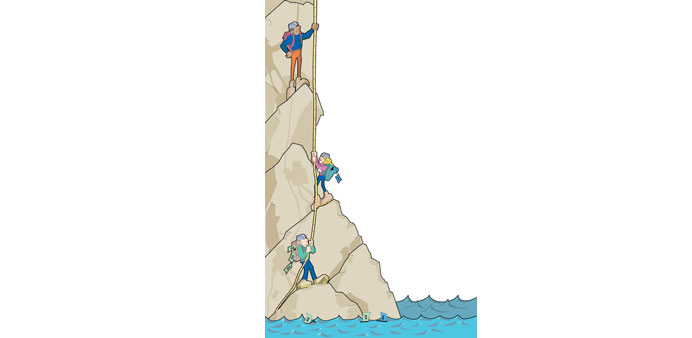By Adair Turner/New York
For two years, financial markets have repeated the same error – predicting that US interest rates will rise within about six months, only to see the horizon recede. This serial misjudgment is the result not of unforeseeable events, but of a failure to grasp the strength and global nature of the deflationary forces now shaping the economy.
We are caught in a trap where debt burdens do not fall, but simply shift among sectors and countries, and where monetary policies alone are inadequate to stimulate global demand, rather than merely redistribute it. The origin of this malaise lies in the creation of excessive debt to fund real-estate investment and construction.
During Japan’s 1980s boom, real-estate loans quadrupled in just four years, and land prices increased 2.5-fold. After the property bubble burst in 1990, over-leveraged companies were determined to pay down their debts, even when interest rates fell close to zero. While large fiscal deficits partly offset the demand-suppressing effects of private deleveraging, the inevitable consequence was rising public debt.
Corporate debt slowly fell (from 140% of GDP in 1990 to about 100% today); but public debt rose relentlessly, and now exceeds 230% of GDP.
Since the financial crisis of 2008, that pattern has been repeated elsewhere. In the US and several European countries, excessive debt creation before 2008 was followed by efforts at private deleveraging, initially offset by large government budget deficits.
Advanced economies’ cumulative private debt-to-GDP ratio has fallen slightly – from 167% to 163%, according to a recent report; but public debt has grown, from 79% to 105% of GDP.
Fiscal austerity has therefore seemed essential; but it has exacerbated the deflationary impact of private deleveraging.
Before 2008, China’s economy was highly dependent on credit expansion, but not within the country itself. Rather, it ran large current-account surpluses – 10% of GDP in 2007 – with credit-fuelled consumption growth in the US and elsewhere powering its export-led economy. Collapsing external demand in late 2008 therefore threatened Chinese growth and employment. In response, China’s government unleashed a massive credit-fuelled construction boom, with investment rising from 42% of GDP to 48%, and total credit growing from around 140% of GDP to more than 220%.
That boom has now ended, leaving apartment blocks in second- and third-tier cities that will never be occupied, and loans to local governments and state-owned enterprises that will never be repaid. Growth in China’s industrial production may be close to zero, even if the official figures suggest a less dramatic decline.
Within China, the consequences for growth may be less dire than some commentators fear: a rapidly tightening labour market is boosting real wages; household consumption is growing strongly; and a buoyant services sector is helping to create 10mn new jobs per year.
But for the global economy, the consequences of the dramatic slowdown in China’s construction and industrial sectors are profound, with a 14% fall in Chinese imports driving commodity producers like Brazil into recession and generating deflationary pressures across East Asia.
Singapore’s economy recorded negative growth in the second quarter; Taiwan’s industrial production was down 5.5% year on year in August; and South Korea’s exports fell 15%.
Even before China’s slowdown, Japan was making limited progress toward its target of 2% inflation in 2016. With the country’s second-quarter GDP falling and August core inflation negative, that target is no longer credible. As a result, the Bank of Japan (BOJ) may increase its already massive quantitative-easing operations.
Faced with mediocre growth and near-zero inflation, the eurozone may also now consider yet more QE. But with the eurozone running a large current-account surplus – Germany’s surplus exceeds 7% of GDP – it is already too dependent on external demand, which is vulnerable to China’s downturn.
The fact is that QE alone cannot stimulate enough demand in a world where other major economies are facing the same challenges. By boosting asset prices, QE is meant to spur investment and consumption. But its effectiveness in stimulating domestic demand remains uncertain. The European Central Bank’s QE programme, for example, has so far produced no significant increase in corporate investment.
Given this, central bank governors like the ECB’s Mario Draghi and the BOJ’s Haruhiko Kuroda often emphasise QE’s ability to deliver competitive exchange rates. But that approach simply shifts demand from one economy to another. And if both Japan and the eurozone use QE to devalue their currencies, other economies – including China – may feel compelled to follow suit.
At the global level, exchange-rate devaluation must be a zero-sum game, with the depreciation of the yen and the euro balanced by appreciation of the US dollar, which is up by more than 15% on a trade-weighted basis since May 2014.
Buoyant domestic demand might offset the deflationary impact on the US economy, but only if interest rates stay low enough to stimulate a resurgence of private credit growth, potentially taking us full circle, to the kind of run-up in leverage that preceded the 2008 crisis.
The United Kingdom has also faced exchange-rate appreciation, with the erosion in export competitiveness reflected in a current-account deficit of around 4% of GDP. The Office of Budget Responsibility suggests, meanwhile, that robust growth will be possible only if household leverage, having fallen slightly since 2008, rises to an all-time high by 2020.
Seven years after 2008, global leverage is higher than ever and aggregate global demand is still insufficient to drive robust growth. More radical policies – such as major debt write-downs or increased fiscal deficits financed by permanent monetisation – will be required to increase global demand, rather than simply shift it around. - Project Syndicate
♦ Adair Turner, a former chairman of the United Kingdom’s Financial Services Authority and a former member of the UK’s Financial Policy Committee, is chairman of the Institute for New Economic Thinking.

The debt mountain...


